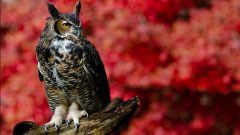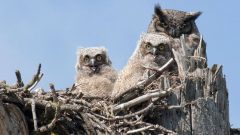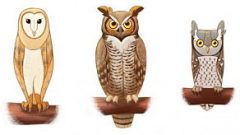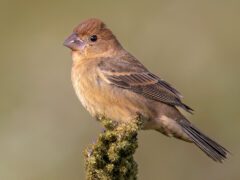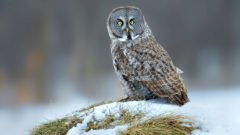Great Horned Owl Similar Species Comparison
Main SpeciesGreat Horned Owl
Adult
Large owl with large ear tufts and yellow eyes. The color of the facial disc varies regionally from gray to cinnamon.
© Mary Rumple / Macaulay LibraryIdaho, September 20, 2015Adult
A hefty bird that flies silently on broad wings.
© Anne Auclair Moe / Macaulay LibraryAlberta, January 04, 2021Adult
Owls can't move their eyes side to side; instead they can swivel their heads more than 180 degrees to look in any direction.
© Timothy Barksdale / Macaulay LibraryNew Mexico, April 01, 1997Juvenile
Juveniles are covered in fluffy down. The head is often downy white and contrasts with the darker facial disc and yellow eyes.
© Bob Lane / Macaulay LibraryFlorida, March 24, 2017Adult
Hefty, upright perching owl with noticeable ear tufts. Plumage coloration varies regionally. Eastern birds tend to have more cinnamon tones.
© Jeremiah Trimble / Macaulay LibraryMassachusetts, April 20, 2017Adult (Great Horned)
Preens feathers by pulling them through its bill.
© Timothy Barksdale / Macaulay LibraryMontana, March 01, 2000Adult
Uses nests built by other species, sometimes adding lining material of their own.
© Lewis Ulrey / Macaulay LibraryIdaho, April 19, 2017Juvenile
Juveniles are covered in fluffy down. White down often retained on the head longer, which contrasts with the darker facial disc.
© Joshua Little / Macaulay LibraryOregon, May 15, 2016Adult male and female
Male and females perform a duet of alternating calls, with the female’s voice recognizably higher in pitch than the male’s.
© Timothy Barksdale / Macaulay LibraryMontana, March 01, 2000Adult
Mottled brown above with bright yellow eyes, a cinnamon facial disc, and a white throat.
© Marty DeAngelo / Macaulay LibraryDelaware, May 12, 2017Adult
Found in woodlands, orchards, and agricultural areas. Sometimes nest in abandoned buildings.
© Irene Crosland / Macaulay LibraryAlberta, January 15, 2016Adult
Nests in trees such as cottonwood, juniper, beech, pine, and others. They usually adopt a nest that was built by another species, but they also use cavities in live trees, dead snags, deserted buildings, cliff ledges, and human-made platforms.
© Tom Johnson / Macaulay LibraryFlorida, January 13, 2014Similar SpeciesGreat Gray Owl
Adult
Great Gray Owls have a larger, grayer head and facial disc than Great Horned Owls and they do not have ear tufts.
© Ian Davies / Macaulay LibraryQuebecSimilar SpeciesBarred Owl
Adult
Barred Owls are slightly smaller than Great Horned Owls. They have dark eyes and a yellow bill, whereas Great Horned Owls have yellow eyes and a dark bill.
© Scott Young / Macaulay LibraryMaryland, January 08, 2017Similar SpeciesAmerican Barn Owl
Adult
American Barn Owls are much paler than Great Horned Owls with a heart-shaped face and no ear tufts.
© Darren Clark / Macaulay LibraryIdaho, January 21, 2017Looking for ID Help?
Get a customized list of birds from anywhere in the U.S. or Canada.
View Birds Near MeSpecies in This Family
Owls(Order: Strigiformes, Family: Strigidae)
More to Read
Search species and articles
Explore birds based on location and time of year.
View Birds Near MeDon't miss a thing! Join our email list
The Cornell Lab will send you updates about birds,
birding, and opportunities to help bird conservation.




















